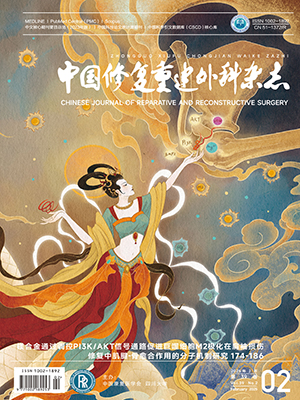| 1. |
Nie C, Yang D, Xu J, et al. Locallty administered adipos-derived stem cells accelerate wound healing through differentiation and vasculogenesis. Cell Transplant, 2011, 20(2):205-216.
|
| 2. |
闫迎军, 乔群, 孙家明, 等. 几丁糖预防硅凝胶乳房假体包膜挛缩的实验研究. 中华整形外科杂志, 2005, 21(2):139-142.
|
| 3. |
施文斌, 董玉英, 董福生, 等. 不同扩张方式对扩张皮肤胶原纤维和肌动蛋白的影响. 实用口腔医学杂志, 2010, 26(1):38-42.
|
| 4. |
李江, 鲁开化, 艾玉峰, 等. 扩张后皮肤软组织收缩机理的实验研究. 中华整形外科杂志, 2002, 18(3):173-174.
|
| 5. |
李薇薇, 冯锐. 富血小板血浆凝胶制备及对大鼠皮瓣成活的作用分析. 中国修复重建外科杂志, 2012, 26(1):64-69.
|
| 6. |
Özdemir B, Kurtiş B, Tüter G, et al. Double-application of plateletrich plasma on bone healing in rabbits. Med Oral Patol Oral Cir Bucal, 2012, 17(1):e171-177.
|
| 7. |
Lee HW, Reddy MS, Geurs N, et al. Efficacy of platelet-rich plasma on wound healing in rabbits. J Periodontol, 2008, 79(4):691-696.
|
| 8. |
Planat-Benard V, Silvestre JS, Cousin B, et al. Plasticity of human adipose lineage cells toward endothelial cells:physiological and therapeutic perspectives. Circulation, 2004, 109(5):656-663.
|
| 9. |
郭垣杉, 颜玲. 无血清培养促进脂肪干细胞向血管内皮细胞分化. 中国组织工程研究, 2013, 17(36):6443-6448.
|
| 10. |
Cao Y, Sun Z, Liao L, et al. Human adipose tissue-derived stem cells differentiate into endothelial cells in vitro and improve postnatal neovascularization in vivo. Biochem Biophys Res Commun, 2005, 332(2):370-379.
|
| 11. |
Deveza L, Choi J, Imanbayev G, et al. Paracrine release from nonviral engineered adipose-derived stem cells promotes endothelial cell survival and migration in vitro. Stem Cells Dev, 2012, 22(3):483-491.
|
| 12. |
Francis AJ, Marks R. Skin stretching and epidermopoiesis. Br J Exp Pothol, 1977, 58(1):35-39.
|
| 13. |
Marshall WR, Godfrey M, Hollister D, et al. Types of collagen in breast capsules. Ann Plast Surg, 1989, 23(5):401-405.
|
| 14. |
刘学军, 郝建忠, 喻理. 皮肤软组织扩张术中维持扩张期对扩张皮肤的影响. 国际医药卫生导报, 2002, (4):48-49.
|
| 15. |
杨宇. 扩张包膜血管构筑的试验研究及其临床应用. 北京:中国协和医科大学, 2006.
|
| 16. |
鲁开化, 周庆红. 皮肤扩张术在美容整形外科应用的现状及未来. 中国实用美容整形外科杂志, 2005, 16(3):129-130.
|
| 17. |
刘文阁, 杨佩瑛, 马桂娥, 等. 罂粟碱作用下扩张器周围纤维包膜超微结构的变化. 中华医学美容杂志, 1997, 3(4):178-181.
|
| 18. |
范昌, 邢宏利, 李丽莎, 等. 透明质酸对扩张囊外纤维包膜影响的临床研究. 山西医药杂志, 2013, 42(5):504-506.
|
| 19. |
刘文阁, 季莹, 杨佩瑛, 等. 曲安缩松加速组织扩张的临床应用研究. 中华整形烧伤外科杂志, 1999, 15(1):41-43.
|
| 20. |
肖海军, 侯春林, 顾其胜, 等. 几丁糖膜预防术后粘连的研究进展. 上海生物医学工程, 2004, 25(3):47-52.
|
| 21. |
仇树林, 闫焱, 张培培, 等. 几丁糖对扩张后皮瓣纤维包膜中毛细血管数量影响的实验研究. 中国美容整形外科杂志, 2008, 19(4):312-314.
|




